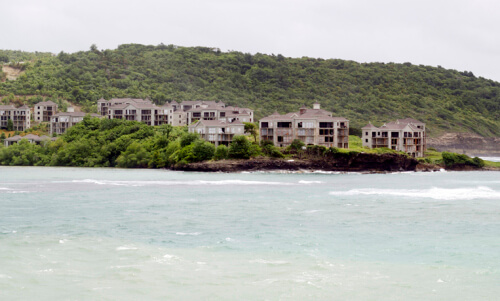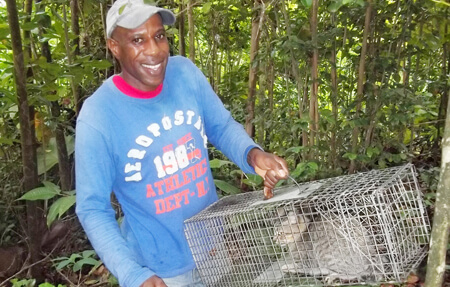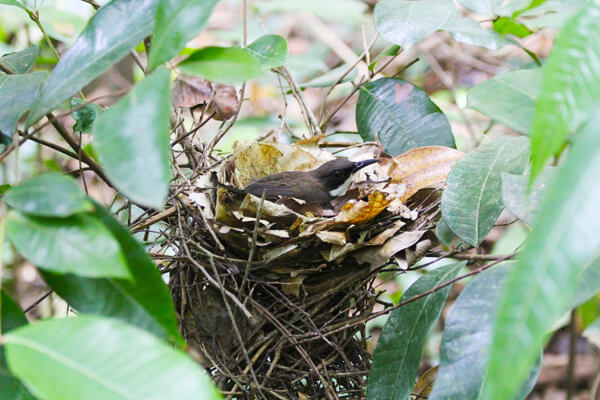The Art of Waiting on St. Lucia's White-breasted Thrasher
By Kate Freeman
While the Caribbean island of St. Lucia has many aspects of a tropical paradise, working in this forest is not exactly white sand and turquoise water. Snake chaps are a critical part of my field gear, as this place is home to the venomous Fer-de-Lance, or St. Lucia viper. Steep, rugged terrain and intense humidity also contribute to this harsh environment, where I'm in my third month of field work.
However inhospitable to humans, this forest is home to several endemic and endangered birds, including the critically endangered White-breasted Thrasher—the reason I am here. My study area holds over 90 percent of the St. Lucia population of this species (about 1,200 individuals), as well as the endangered St. Lucia Black Finch, the endemic St. Lucia Warbler, the endemic subspecies of Lesser Antillean Flycatcher, and 13 other range-restricted species. I hope to learn more about the thrasher's conservation needs, so plans can be made to ensure its survival.
Into the Forest
I wring out my handkerchief and wipe my brow, trying to ignore the sweat beading on my spine and dripping down my shins. After a steep ascent, we are standing in a grove of bwa gwiyé and bwa kewol trees—small deciduous trees that dominate the Mandelé dry forest on the east coast of St. Lucia. This forest borders the town of Praslin, a small fishing village that is home to about 300 hundred St. Lucians. Blue flags mark nest #36, a large open cup, loosely woven out of dried sticks and leaves and containing two brilliant blue eggs.
The smell of rotting mangoes, littering the forest floor, is pungent in the midday heat. My heart leaps as I see a dark flash of motion up ahead, but I am once again fooled by an anole (lizard), leaping from branch to branch. Michael Philigence, my local field assistant and forest guru, shoots me a look from his crouched position; “Patience,” I know he is thinking.
I would not make it far in the forest without Michael's intuition and navigational abilities. A Praslin native, Michael grew up with the forest as his backyard. Armed with no more than a cutlass (the local Kwéyòl word for machete), Michael moves with swift grace, darting under low branches and leaping over fallen logs. I pant, sweat, and trip along behind, exerting all of my effort just to keep up with him. In addition to a seemingly photographic memory of the forest, Michael is also a huge help with nest searching.
On Island Time
Thrashers nest at three to ten feet in understory trees, predominately bwa gwiyé. Michael has an amazing ability to find a nest. He can point them out before even seeing them, while I may spend 20 minutes searching for one that is directly in front of me. He must have found more than half of the 85 nests we tracked this season.
Beyond nest searching, our daily tasks include mist-netting and banding adult thrashers. Mist-netting around a nest in the forest is no small task. The steady swing of Michael's cutlass, cutting and stripping the bark of saplings for nest poles, is crucial. Together we must maneuver a pair of six-meter nets around the nests without disturbing any surrounding vegetation. (I believe it is a new form of tropical martial arts!) Once the nets are in place around the nest comes the “art of waiting.” These tropical critters seem to move on island time. Unlike the frantic rush of the breeding season I'm accustomed to in the Northern Hemisphere, these thrashers may wait 40 minutes or more between nest visits.
I crouch low, careful not to touch the forest floor for fear of chiggers, fire ants, venomous snakes, and stinging plants. After five minutes of stillness, Michael points to a branch above my head. I smile and look up, reaching for my binoculars. A stark white breast stands out against sleek black plumage. I will never tire of the sight of a White-breasted Thrasher. This bird has no fancy bells or whistles, but an understated elegance which makes it as attractive to me as the brightest tropical bird.
Through my binoculars, I read “Red-Green” and “Orange-Silver” combinations of bands on the bird's long legs. I now know that this bird is the breeding female, coming to keep a watchful eye on her eggs.
A Future for the Thrasher
The White-breasted Thrasher, known in Kwéyòl as Gorge Blanc (white throat), inhabits dry river valleys in eastern and northern St. Lucia. There is only one other small population of White-breasted Thrashers, on the neighboring West Indian island of Martinique. Introduced mammals and habitat destruction are the primary threats to these rare and endangered birds. The subpopulation where I am working in Mandelé, St. Lucia, now faces an immediate crisis: a 500-plus-acre resort under construction that has destroyed 37 percent of the thrasher's total habitat.

Condominium development on St. Lucia, part of an abandoned development that has fragmented habitat. Photo by Kate Freeman.
Forest once occupied by White-breasted Thrasher, and essential for its successful nesting, was cleared in 2006 for a golf course and residential resort. In addition to outright habitat destruction, fragmentation from the resort development created an “edge effect,” exposing the now-small forest patches to invasive predators along forest borders and increasing nest predation.
Deforestation and the resulting erosion have turned a once-productive native forest into a desiccated wasteland. Nonetheless, thrashers continue to nest in high density in the forest patches between the golf course fairways. I am investigating the thrashers' behavioral shift resulting from this changed ecosystem. Cooperative breeding, where three to six adults collectively care for nestlings in one nest, is more prevalent among thrashers in the fragments than those nesting in intact forest. I am monitoring nests in both the fragments and a nearby forest reserve to compare nest success, behavior, and the impact of predation.

Michael Philigence with cage trap, part of our effort to estimate mammal density and diet. Photo by Kate Freeman.
Thanks to the support of American Bird Conservancy, I am including small mammal trapping in my conservation study this year. The forest fragments on the golf course are a perfect home to introduced mammals such as cats, rats, Indian mongoose, and opossum. These mammals are significant predators of the White-breasted Thrasher and are a particular threat to nestlings and fledglings. We set cage traps throughout the forest fragments to estimate mammal density and diet. Because thrashers are endemic to the West Indies, they evolved in the absence of these mammalian predators and lack the instincts to protect themselves. Removing cats and mongoose from the site is showing to be an effective measure in increasing thrasher nest success.
This critical wildlife habitat may disappear if conscious conservation measures are not taken in St. Lucia. Continued research and educational outreach are critical to protect White-breasted Thrashers—and the environmentally and culturally rich ecosystem where these birds live.
 Kate Freeman is a graduate student in biology at Villanova University. She spent May-August 2013 in St. Lucia studying the White-breasted Thrasher for her thesis research.
Kate Freeman is a graduate student in biology at Villanova University. She spent May-August 2013 in St. Lucia studying the White-breasted Thrasher for her thesis research.



















































